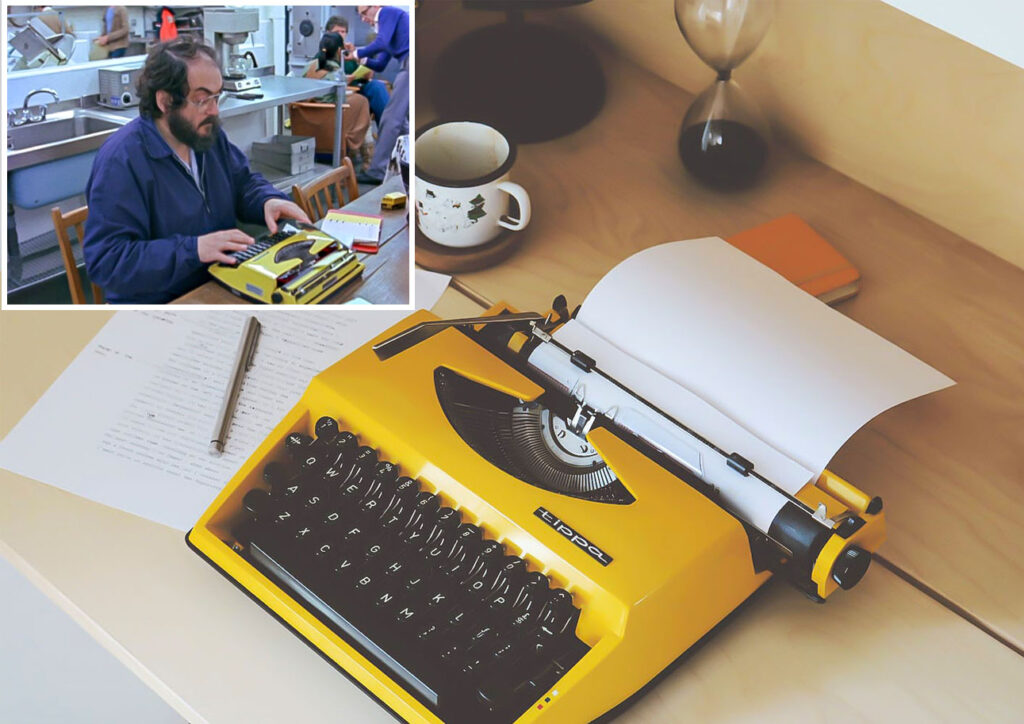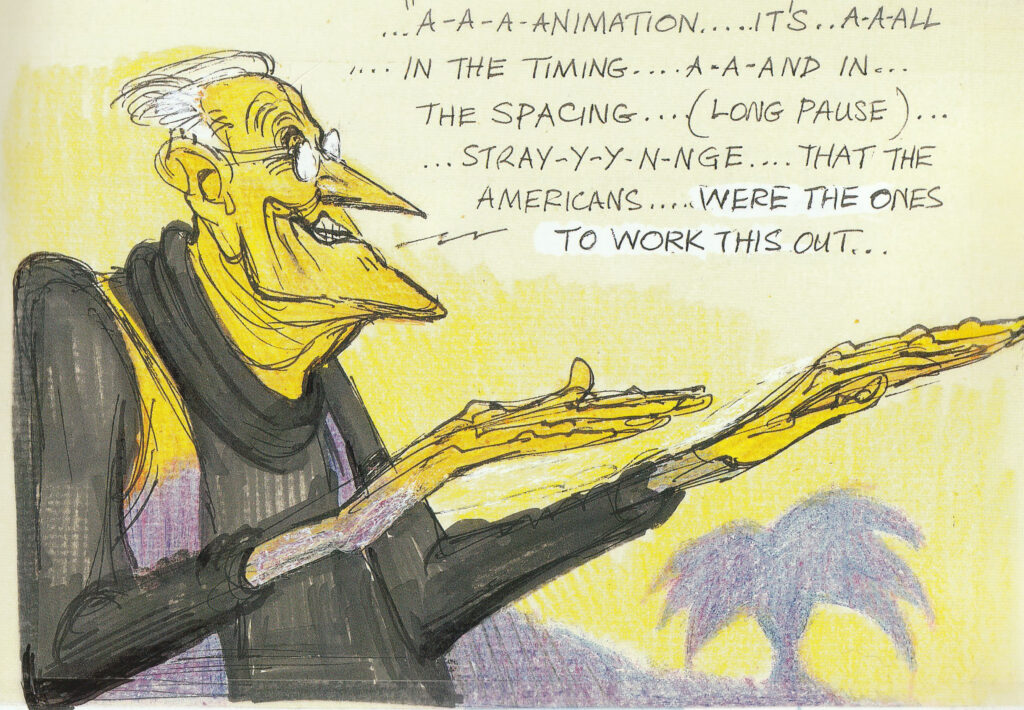
But “storytelling” is not synonymous with “scriptwriting”…
Well, we have therefore finally established what the “raw material” of the animator as an artist is, his clay to model, his paint to spread on the canvas, his sounds to align on the pentagram: it is movement, an impalpable yet very visible “matter”, intimately linked to the primary roots of natural physics, that is, space and time. Outside of the interaction between these two dimensions, movement simply does not exist, it is no more a phenomenon that is part of our experience.

It is no coincidence, as we will have the opportunity to analyze later, “Spacing” and “Timing” are the two pivots around which the entire art of animation revolves. Grim Natwick, quoted by Richard Williams, famously argued that “Animation it’s all in the Timing and in the Spacing” (Adding, again according to Williams: “Strange that the Americans were the ones to work this out”, which instead it is not completely true on my humble opinion, on the contrary it seems to me that it is rather logical that it was the Americans who did it).
In this scenario, the animator is the artist who knows how to shape the forms, times, rhythms of this space-time flow that we call the “movement”, so as to derive meaning and emotions from it. In other words, life.
Again, it is no coincidence that the very name of “animator” or “animation” comes from the Latin root of “animatio”, which literally means “to give life”, “to infuse life”.
But naturally this “magic”, this generative miracle, as happens in all forms of art, has a precise purpose, that is that of telling a story.
That is, something that concerns us in some way, that involves us emotionally, sensorially, sentimentally, in which we can identify and derive some meaning from our existence
We mentioned, a few pages back, the dichotomy between the synchronic and diachronic arts, defining the latter as those which, like cinema and animation (and music, literature, theatre etc.), deal with a transformation, a mutation, of any kind, which develops over the course of a span of time.
While an art that we can define as perfectly synchronic, such as sculpture, stages a narrative entirely internal to the shape and the spatial dimension, devoid of any temporal dimension (apart from the “implicit” one linked to the historical and cultural moment in which it is conceived and created), a diachronic art develops its narrative over a certain actual and measurable time frame.
For example, music, which we can consider the purest of the diachronic arts as it is solely devoid of the visual and spatial dimension, rearranges a series of sounds along the temporal axis to express an emotion, a concept, a virtual dialogue, through harmonic and melodic development, thus implying a “story”, and, metaphorically, even the spacial location in which the same story takes place.
Similarly, with animation as we understand it in these reflections, a series of movements are sequenced, articulated according to the laws of physical, perceptive and psychological coherence to “give life” to objects/characters, in order to convey emotions, thoughts, actions and reactions to the environment, correlations and interactions with other coexisting objects/characters.
In this scenario, the artist’s work never stops at the simple description or reproduction of such movements, treating them as more or less complex but isolated and self-contained physical events: on the contrary, every movement, every action, every “event” refers to the previous and anticipates the subsequent, composing an intelligible narrative arc, or rather, again, to tell a story.
In the video above [Fig 18.01] I return to our previous example, with a character making a simple leap following the primary principles of animation, such as anticipation, squash and stretch, spacing and timing. A “second level” of reading was already present, with the character’s expression appearing to connote the jump as due to a feeling of fear, surprise, discomfort.
However, this “fright”, despite being clearly characterized not only by the facial expression, but also by the entire context of the action being performed, lacks any element that justifies it, that makes it coherent and psychologically plausible and in which the observer can identify. For now it still remains an isolated event, concluded in itself, purely described, but without a past or a future, in other words, without a dramatic development: without a story.
However, if I add, without modifying anything of the character’s action, a new moving element, such as the triggered bomb in the example above [Fig 18.02], the observer’s perception immediately interprets the event as a chain of events that presuppose a previous situation and a subsequent development, a cause and an effect.
So, we finally told a story.
To explain myself better, I return for a moment to our old “billiard balls”, so as to reduce the scenario to the bare minimum. In this example I only changed the size of object [A], making it much larger than object [B]. Our perceptual system, based on innate experience, reads this dimensional difference as a “threat” by [A] towards [B], and consequently infers [B]’s movement away as an escape, attributing the motivation to the fear of the smaller object (perceived as weaker) towards the larger one (perceived as stronger). In this case we have constructed an intelligible micro-narrative cell which reads: “[A] approaches threateningly to [B], who runs away in fear”. By increasing the escape velocity and changing the latency time we can change the escape into something even stronger, like “terror”. If instead we slow it down, we will read the action as a simple moving away (to see better?) [Fig 18.04]
The interesting thing is that, when we are inside the narrative, we can also change, or even contradict the expectations set up by our perceptive system, which we have defined as “instinctive”.
For example, we can make the biggest ball to “run away” [Fig 18.05], thereby creating a “surprise” and therefore a possible comic effect [Fig 18.06], according to the classic Freudian definitions of “joke”. (“Jokes and Their Relation to the Unconscious” – Der Witz und seine Beziehung zum Unbewußten, Sigmund Freud,1905).
At this point it should be underlined that when speaking of “storytelling” here I do not mean talking about plot, dramatic development, or rather anything that is the responsibility of writers, scriptwriters and storyboard artists. Storytelling here is understood only as the primary cell of narration, expressed by every movement or action of the character (of the actor), which must contribute to the progress of the general plot of the story, without redundancy, without omitting, without deviating from the main path. Only in this way will the gesture, the action, the emotion of the character (actor) be effective, and felt as essential, indispensable, and inevitable.
In other words, in our work every single movement, every action, every change of expression is never an end in itself, but must contribute in an essential way to the progression of the story that is intended – that the play in its entirety intends – to narrate.
In the previous example, the fact that a bomb enters the field presupposes a narrative situation that justifies it (Who threw it? Why they did it? What is the link between this action and the presence of the character on the scene? What led him to being in that very place? What is the relationship between him and the character who threw the bomb?). In the same way, the event must find a justification consistent with what will happen (that we want, or that our director wants to happen) during the subsequent narration (The character dies? Or disappears? Or stays burned on the scene? The character who threw the bomb laughs? Or is disappointed for not having somehow obtained the result he expected? Or is upset because he didn’t expect the bomb to actually explode? etc.).
As we have seen, the fragmented nature of the animation work, entirely concentrated in the analysis of the action of a single character within a single scene assigned in the order and times established by the work plan, can very easily lead to lose sight of the main road and introduce elements of redundancy, disturbance, even contradiction, which can distract or even distort the understanding of the main story.
For example, if our character at the end of his jump, instead of having a scared expression simply smiled, the meaning of the whole action would change radically, and together with it, inevitably, also the meaning of the story [Fig 18.07].
Naturally this is an extreme example, but it demonstrates how nothing that moves within a scene can be considered neutral, isolated in itself. We are in a diachronic art, as we have said, and therefore everything is inevitably inserted in a sequence, in a space-time chain, in which every single link can determine the solidity or instead the fragility of the narrative line. If one of these links breaks, the entire construction loses its bond and risks being lost in nonsense [Fig 18.08] .
This leads us to define another fundamental concept, namely the essentiality of the movement, of the gesture, of the action performed on stage, in the sense of its irreplaceability or necessity and in that of its conciseness, simplicity, effectiveness.
In theatrical and cinematographic acting, “overacting” is defined as the acting of an actor who adds superfluous elements to the action, for example waving his hands too much, exaggerating movements and expressions, indulging in useless gestural or vocal virtuosity. Similarly, “overanimation” is defined as the action of a character in which the secondary actions are too abundant, unjustified, detached from the context of the main action, perhaps inserted only to show the technical skills of the animator. An error that is unfortunately much more common than one might imagine, so much so that we can see traces of it even in high quality films, particularly in 3D CGI animation, where it is relatively easy to exaggerate, since much of the dirty work is done by the machine .
Just as a witness in a trial is asked to tell “the truth, the whole truth, nothing but the truth”, the animator of a scene is asked to tell “the story, the whole story, nothing but the story”.
Returning to the daily work of an animator, in particular if employed in a medium or big studio, as I mentioned above his work is similar to that of an actor engaged in a dramatic role, but his acting technique differs from that of the stage actor and instead comes very close to that of the cinema.
Often in non-specialised literature, and therefore in the eyes of the common public, animation is treated just as one cinematographic genre among many (drama, western, horror, romcom, musical, historical, comedy, noir, etc.), but this is a completely superficial and ahistorical definition, because animation should rather be considered as a sort of “parallel cinema”, in which the various genres are included, as a reflection or parody of those of live action movies. Essentially what differentiates it from the latter is the generative technique, which operates discrete on the single frame rather than on the reproduction of a continuous staged action.
In any case, what matters in this discussion is that animation is to all intents and purposes cinema, and it fully shares its language. But that’s not all.
Precisely due to the nature of its technical execution it can push certain characteristics to the extreme: the animator not only works in a fragmented way on the single scene as determined by the production plan, but unlike the actor who is physically present on the stage or the set together with other actors, technicians, directors etc., he works more or less isolated on his desk, or on his computer, and does so by exercising in the meantime extreme analytical attention on the movement of the character he is animating, in order to obtain the desired action, and this, in fact, down to the single frame.
The animator’s work is first and foremost a work of analysis, he breaks down the movement, he dissect it, like on an autopsy table, down to the smallest detail, This is precisely inherent in the basic method, divided into extremes, keys, breakdowns and inbetweens. For this reason it is much easier to lose sight of the “synthesis”, the sense of what we are doing within a story, and it is easier to indulge in redundancy, distracting actions, and showing one’s virtuosic whims .
The animation must instead be like the clear and clean bed of a stream carrying the water to push the blades of the mill, without dispersing into secondary branches, vortices and eddies, shallows and swamps.
To give an example taken from the “masters”, we can compare the almost perfect animation created by Milt Kahl in the famed sequence of Shere Khan meeting Kaa in “The Jungle Book”, with that of the raven Jeremy (voiced by Dom DeLuise) in Don Bluth’s “Brisby and the Secret of NIMH”.
In the first example [Fig 18.09] every single movement is calibrated to the millimeter, the composition is perfect, there is not even a single movement that can distract attention from the main action, and when there is, for example the nervous albeit restrained movement of Shere Kahn’s tail, is always completely functional to the narrative. Milt Kahl even chooses to entrust the entire lower part of SK’s body to a held cel, which is rather unusual in Disney full animation, but it is a conscious choice, due not so much to the need to saving time and work, as well as not disturbing the perception of the scene in any way.
In the second example [Fig 18.10], however, the crow is rather overanimated: too many primary, secondary and even tertiary movements end up distracting from the main action, in the same way that a magician’s hands distract the audience’s attention from the trick he is performing. Don Bluth’s film obviously remains a jewel in the history of animated cinema, a small masterpiece without which the entire subsequent “rebirth” of Hollywood (and off Hollywood) animation could not be explained, after the painful industrial, creative and technical crisis of the 1980s. However, evidently, in their desire to give their best, the formidable crew of animators involved in the project (certainly not favored by serene working conditions, always racing against very tight deadlines and uncertain budgets) tended to overdo it, also out of pure enthusiasm.
In summary, the art of the animator, like that of the actor, with which it has so much in common, but also like every other artistic expression, is fundamentally the art of the essential, of the maximum effect with the minimum effort.
While in life, in reality, redundancy is often a rule – there are so many stimuli and signals that we must untangle to give meaning and coherence to this reality – in the field of artistic expression, and in the related field of representation, everything that is acted or said is functional to the underlying theme of the narrative, it is the center of gravity on which everything depends and on which everything must fall.
To obtain this synthesis, this essentiality, it is obviously necessary to work a lot on the technical tools that you have available, with continuous and tireless study, exercise and refinement of your skills. But once you are in the game, with the scene on the desk, and the delivery times pre-established, there is no point in panicking or rushing, in fact it is decidedly counterproductive. It is a very common mistake, even among the most experts, including myself, to rush into animating the newly opened scene, relying on the layout and – when there are – on the posing and the director’s notes; but this irresistible temptation must be resisted.
Instead, first of all it is necessary to stop and reflect for a while, reread the script at least in the closest parts of the scene that is being animated, review the videoboard, if available review the animation of the previous scenes, rethink the character and try to think with his head, dressing not only with his appearance, but with his emotions, his thoughts, his motivations. This is an essential process that should not only be carried out at the beginning of a new sequence or episode, or during a meeting with the director, but always, every time you start working on a scene.
Finally, our character, which we embody as actors, enters the narrative, the story, and begins his journey, his true adventure.
In the last article of this chapter we will touch on one last topic, just as fundamental as the previous ones, but extremely volatile, difficult to define, even if it constitutes the true first spark that distinguishes an authentic artist from any other person, and at the same time it is the “added value” that each of us can exploit throughout our career: the individual talent.
19 – Talent: Skill or Genius?
